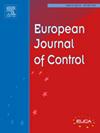具有DoS攻击的不确定周期分段多项式时变系统的扰动估计安全跟踪控制设计
IF 2.6
3区 计算机科学
Q2 AUTOMATION & CONTROL SYSTEMS
引用次数: 0
摘要
本文研究了不确定周期分段多项式时变系统基于改进的等效输入干扰(EID)方法,考虑大量脆弱因素的安全抗扰鲁棒跟踪控制问题。具体来说,检查包括线性分数参数不确定性随机性,外部干扰,随机发生的增益波动,时变延迟和拒绝服务(DoS)攻击。此外,为了对抗扰动足迹,提出了一种基于周期分段多项式特征的改进EID技术。具体来说,滤波后的干扰估计与实际EID值之间的差异被最小化,从而提高了抗干扰能力。因此,为了使系统更加安全并反映典型情况,观察者管理考虑了DoS攻击。在此基础上,根据参考模型,注入由改进的EID概念得到的扰动估计,建立控制律。此外,为了使控制律对误差具有更强的鲁棒性,控制段经历了随机线性分数形式的增益变化。此外,利用矩阵多项式引理和李雅普诺夫稳定性理论,提出了实现本研究主要目标的前提条件。在本研究的最后一部分,作为证明控制设计和理论发现的有效性和生产力的一种方式,给出了数值例子和模拟结果。本文章由计算机程序翻译,如有差异,请以英文原文为准。
Disturbance estimator-oriented secured tracking control design for uncertain periodic piecewise polynomial time-varying systems with DoS attacks
The research offered here discuss the topic of secured disturbance rejection-oriented robust tracking control for uncertain periodic piecewise polynomial time-varying systems by relying on the modified equivalent-input-disturbance (EID) approach, taking numerous vulnerable elements into account. Specifically, the examination encompasses linear fractional parametric uncertainties with randomness, external disturbances, randomly occurring fluctuations in gain, time-varying delays and denial-of-service (DoS) attacks. Moreover, to contend with the disturbance footprints, a modified EID technique is developed under the periodic piecewise polynomial character. Specifically, the discrepancy between the filtered disturbance estimate and the actual EID value has been minimized, thereby improving the capability to reject disturbances. And so, to make the system more secure and reflect the typical circumstances, the observer management takes DoS attacks into account. On top of that, in accordance with the reference model, the control law is developed by infusing the disturbance estimation which is procured from the modified EID notion. Furthermore, the control segment undergoes the gain variation that takes random linear fractional form with the intent to make the control law more robust to errors. Besides, the prerequisites for the main goal of this research are laid out through the utilization of matrix polynomial lemma and the theory of Lyapunov’s stability. In the closing part of this investigation, as a way to demonstrate the efficacy and productiveness of the control design and the theoretical discoveries made, numerical example along with the simulated outcomes are presented.
求助全文
通过发布文献求助,成功后即可免费获取论文全文。
去求助
来源期刊

European Journal of Control
工程技术-自动化与控制系统
CiteScore
5.80
自引率
5.90%
发文量
131
审稿时长
1 months
期刊介绍:
The European Control Association (EUCA) has among its objectives to promote the development of the discipline. Apart from the European Control Conferences, the European Journal of Control is the Association''s main channel for the dissemination of important contributions in the field.
The aim of the Journal is to publish high quality papers on the theory and practice of control and systems engineering.
The scope of the Journal will be wide and cover all aspects of the discipline including methodologies, techniques and applications.
Research in control and systems engineering is necessary to develop new concepts and tools which enhance our understanding and improve our ability to design and implement high performance control systems. Submitted papers should stress the practical motivations and relevance of their results.
The design and implementation of a successful control system requires the use of a range of techniques:
Modelling
Robustness Analysis
Identification
Optimization
Control Law Design
Numerical analysis
Fault Detection, and so on.
 求助内容:
求助内容: 应助结果提醒方式:
应助结果提醒方式:


